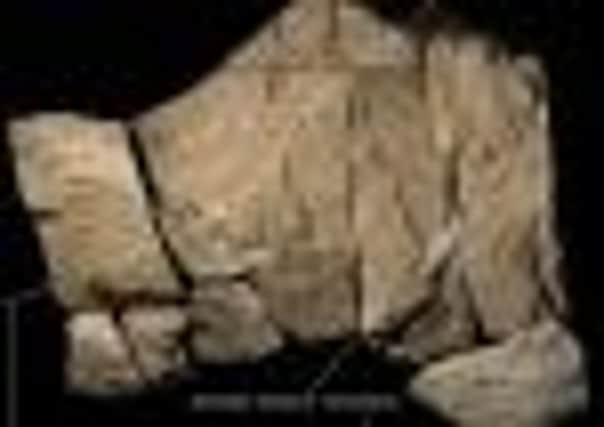Oldest cave paintings are revealed after 37,000 years in the dark


Anthropologists say the block of engraved limestone constitutes the earliest evidence of wall art, which carbon dating shows are 37,000 years old.
The images include animals, the genitalia of a woman and geometric forms.
Advertisement
Hide AdAdvertisement
Hide AdStained with ochre, they were unearthed by an international team of scientists who have been excavating at Abri Castanet, on the river Vézère, in Sergeac in the Dordogne region, for 15 years. The decorations were on a ceiling of a collapsed rock shelter and were created by the first modern humans, known as Aurignacians.
Abri Castanet and its sister site Abri Blanchard have long been recognised as among the oldest sites in Europe or Asia bearing artefacts of human symbolism.
Hundreds of personal ornaments have been discovered including pierced animal teeth and shells, ivory and soapstone beads, engravings and paintings on limestone slabs.
Professor Randall White, of New York University, said: “Early Aurignacian humans functioned, more or less, like humans today.
“They had relatively complex social identities communicated through personal ornamentation, and they practised sculpture and graphic arts.”
In 2007, the researchers discovered an engraved block of limestone weighing 1.5 tonnes in what had been a rock shelter occupied by a group of Aurignacian reindeer hunters.
Subsequent geological analysis revealed that the ceiling had been about two metres above the floor on which the Aurignacians lived – within arms’ reach.
The clearest observable engraving is believed to be that of a woman’s vulva. Such images appear regularly in prehistoric cave art as symbols of fertility.
Advertisement
Hide AdAdvertisement
Hide AdNext to it is a line that suggests the contour of an unfinished beast – possibly a bison – composed of the head and front legs.
Other artefacts, such as tools made from bones and reindeer antlers, were found on the living surface.
Prof White said the paintings were older than the spectacular Chauvet cave paintings discovered in 1994 in the picturesque Ardèche region, which depict horses, rhinoceroses and other animals.
The discovery, along with others of about the same period in southern Germany, northern Italy, and south-eastern France, raises new questions about the evolutionary and adaptive significance of art and other forms of graphic representation in the lives of modern human populations.
The Aurignacian culture existed until roughly 28,000 years ago.
The purpose of cave art is widely debated and is most often linked with the work of shamans, religious specialists who may have painted the walls in memory of past or support of future hunting trips.
Cave art was once considered evidence of a “creative explosion”, when the minds of ancient humans became fully developed.
There is some argument to be made that modern graffiti is a continuation of that same tradition.